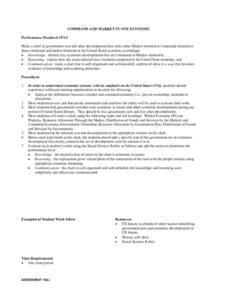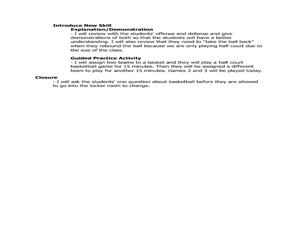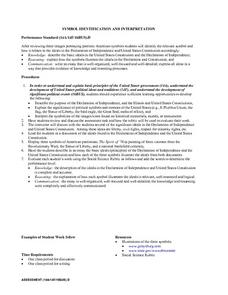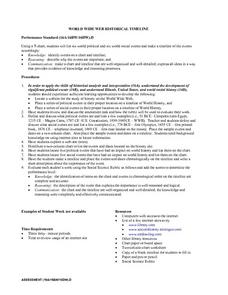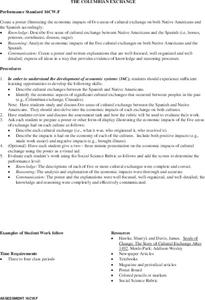Curated OER
Group Dynamics
Students define the purpose of different groups. Using photographs, they practice identifying the group affiliation to one another and describe their characteristics in the picture. They discover the similarities and differences with...
Curated OER
Cultural Exchange
Students are introduced to the concept of cultural exchange and identify two examples of the concept. Individually, they research two specific examples of exchange and write about how it affected the two groups involved. They identify...
Curated OER
Indentured Servants
Students read the article, "Misery." and take notes about reasons immigrants came to America, their physical treatment on the journey, living conditions when they arrived in America, and benefits at the conclusion of servitude. Students...
Curated OER
Command and Market in One Economy
Students organize governmental acts on a chart as either a Market or Command economy. In groups, they note the characteristics of each type of economy and identify their differences. They also explain any item that is related to the...
Curated OER
Pluralism
Students analyze advantages and disadvantages of living in a plurlistic society. They work in groups, to identify the various groups (blacks, whites, Asians, and Coloureds) in the era of apartheid in South Africa by using primary and...
Curated OER
Building a Bridge
Third graders discover architecture and functionality by constructing a bridge. In this bridge engineering lesson, 3rd graders utilize cardboard, straws, towel tubes and plastic bottles to create a model bridge similar to ones seen in...
Curated OER
Basketball/Tumbling
Learners play basketball games and show knowledge of offense and defense. In this basketball lesson plan, students also answer short answer questions about offense and defense.
Curated OER
Ancient Egyptian Culture
Fifth graders participate in a Webquest on Ancient Egypt. They identify clothing and jewelry, list the steps of mummification, decipher hieroglyphics, and complete a Travel Log.
Curated OER
The Halifax Explosion: Who Was Responsible?
Learners investigate who or what was most responsible for the tragedy of the Halifax Explosion.
Curated OER
Democracy is Cool
Students discuss the components of a representative democracy. In groups, they create a t-shirt that shows the components and why it is "cool" to live in a democracy. As a class, they examine the concept of the common good and how...
Curated OER
Producers of Goods and Services
Students use newspapers to brainstorm a list of the producers of goods and services in their community. In groups, they organize coupons based on the good or service and create a chart to organize the information. They discuss the...
Curated OER
Functions of the Three Branches of Government
Learners research the branches of government and write summaries about both the state and federal systems. After conducting reaserch in texts and online, students create Venn diagrams displaying the governmental functions of the three...
Curated OER
Social Studies: Symbols of the United States
Students research the political traditions of the United States at the national and state levels. After discussing various symbols, students compose essays about the principles expressed in the Declaration of Independence and Constitution.
Curated OER
CANDIDATE COMPARISON
Learners identify the names of major contemporary political parties. They explain why a person might choose to vote for one candidate for President of the United States over another candidate. They identify the two major political...
Curated OER
Transportation History
Students research the major developments in transportation. In groups, they use this information to plot them on a timeline. They also write a paragraph about how advances in technology have changed the world. As a class, they discuss...
Curated OER
Lemonade Stand
Students plan a lemonade stand to compete with another stand and examine their decisions from the consumer and producer's point of view. They discuss the law of supply and demand, plan for their lemonade stand, and write an essay...
Curated OER
Hunters/Gatherers
Middle schoolers discuss the ways in which an environment is used to provide the basic necessities of life. In groups, they compare and contrast how different hunter and gatherer groups have used the environment to their advantage. ...
Curated OER
World Wide Web Historical Timeline
High schoolers use newspapers and magazines to identify six recent political and social events from around the world. In groups, they use a timeline template to place the events on the timeline in chronological order. They share with...
Curated OER
PRODUCTION, CONSUMPTION, AND INCENTIVES
Fifth graders design a web page. They include features he or she would typically like to see when visiting web pages. They title the topic of the web page "Features That Make a Great Web Site." They explain that there are incentives...
Curated OER
Malcolm X and Race Relations
Students read sections of Malcolm X's autobiography. In groups, they create a poster which highlights the events in his life and explains his philosophy on race relations. They present their poster to the class and answer any questions...
Curated OER
The Columbian Exchange
Students are introduced to the events of the Columbian Exchange. In groups, they identify and describe five main areas of cultural exchange between the Spanish and the Native Americans. They examine the economic impact of each area on...
Curated OER
Slave Narratives
Students examine many different slave narratives living in the 1700s. In groups, they identify and describe the major events in their lives and arrange them into chronological order. They use this information to create a timeline and...
Curated OER
New Technologies
Students analyze how technology has changed over time. They identify technologies that did not exist in the past and might be invented in the future and design a poster that illustrates the evolution of one kind of technology and...
Curated OER
Economics: People as Producers and Consumers
Students examine the dual roles of producers and consumers in people by creating fictional stories that include examples of both. Their stories include descriptions of the tools and skills needed for the jobs of their characters and...





